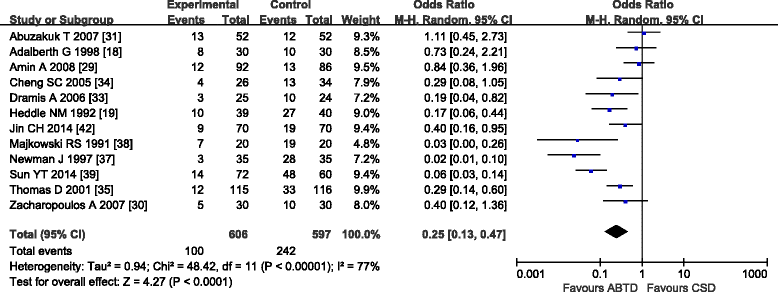The efficacy and safety of autologous blood transfusion drainage in patients undergoing total knee arthroplasty: a meta-analysis of 16 randomized controlled trials
- PMID: 27806693
- PMCID: PMC5094026
- DOI: 10.1186/s12891-016-1301-7
The efficacy and safety of autologous blood transfusion drainage in patients undergoing total knee arthroplasty: a meta-analysis of 16 randomized controlled trials
Abstract
Background: Autologous blood transfusion drainage (ABTD) has been used for many years to reduce blood loss in total knee arthroplasty (TKA). We evaluate the current evidence concerning the efficiency and safety of ABTD used in TKA compared with conventional suction drainage (CSD).
Methods: We performed a systematic literature search of the PubMed, Embase, Cochrane Library and four Chinese databases. All randomized controlled trials (RCTs) that compared the effects of ABTD versus CSD in TKA were included in the meta-analysis.
Results: Sixteen RCTs involving 1534 patients who compared the effects of ABTD versus CSD were included. Five of the RCTs were performed in Asia, ten in Europe, and one in North America. Patients in the ABTD group had a lower blood transfusion rate (OR: 0.25 [0.13, 0.47]; Z = 4.27, P < 0.0001) and fewer units transfused per patient (WMD: -0.68 [-0.98, -0.39]; Z = 4. 52, P < 0.00001) than did patients in the CSD group. Wound complications, deep vein thrombosis, febrile complications, post-operative hemoglobin days 5-8, drainage volume, and length of hospital stay did not differ significantly between the two types of drainage systems.
Conclusion: This meta-analysis suggests that ABTD is a safe and effective method that yields a lower blood transfusion rate and fewer units transfused per patient in TKA compared with CSD.
Keywords: Autologous blood transfusion drainage; Meta-analysis; Randomized controlled trials; Total knee arthroplasty.
Figures












References
-
- Sehat KR, Evans RL, Newman JH. Hidden blood loss following hip and knee arthroplasty. Correct management of blood loss should take hidden loss into account. J Bone Joint Surg Br. 2004;86(4):561–5. - PubMed
Publication types
MeSH terms
Substances
LinkOut - more resources
Full Text Sources
Other Literature Sources
Medical

